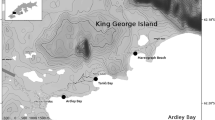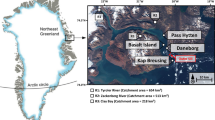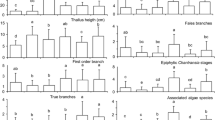Abstract
Frondose macroalgae usually harbors a diverse epifaunal community, whereas sediment among the fronds tends to decrease species richness and diversity. The macroalga Caulerpa racemosa is found in shallow waters and can trap sediment among its stolons. We investigated how the peracarid assemblages from two shores in southeastern Brazil are related to temporal changes in the algal biomass, sediment quantity trapped in C. racemosa patches, and organic matter content from adjacent areas. On both shores, there was no significant difference in the algal biomass through time. Algal clumps from Fortaleza retained at least four times more sediment than from Cigarras, and similar temporal trends of sediment retention were observed at both shores. Overall, 47 species of peracarids were identified. Assemblages from Cigarras were richer and more diverse but remained constant through time. Assemblages from Fortaleza had variation in peracarid species and feeding habits through time, with omnivorous and detritivorous species dominating periods of high loads of sediment. While the presence of sediment seems to negatively affect the abundance and diversity of the epifaunal assemblage, it may favor the presence of detritivores, and tube-building species.



Similar content being viewed by others
References
Airoldi L (2003) The effects of sedimentation on rocky coast assemblages. Oceanogr Mar Biol 41:161–236
Anderson MJ (2005) PERMANOVA: a FORTRAN computer program for permutational multivariate analysis of variance. Department of Statistics, University of Auckland, New Zealand
Appadoo C, Myers AA (2003) Observations on the tube-building behaviour of the marine amphipod Cymadusa filosa Savigny (Crustacea: Ampithoidae). J Nat Hist 37:2151–2164
Belton GS, van Reine WF, Huisman JM, Draisma SG, D Gurgel CF (2014) Resolving phenotypic plasticity and species designation in the morphologically challenging Caulerpa racemosa-peltata complex (Chlorophyta, Caulerpaceae). J Phycol 50:32–54
Bueno M, Tanaka MO, Flores AAV, Leite FPP (2016) Vertical differences in species turnover and diversity of amphipod assemblages associated with coralline mats. Estuar Coast Shelf Sci 181:153–159
Bulleri F, Balata D, Bertocci I, Tamburello L, Benedetti-Cecchi L (2010) The seaweed Caulerpa racemosa on Mediterranean rocky reefs: from passenger to driver of ecological changes. Ecology 91:2205–2212
CETESB (Companhia de Tecnologia de Saneamento Ambiental) (2007) Relatório de monitoramento de emissário submarino. Secretaria de Estado do Meio Ambiente, Série Relatório 116pp
Christie H, Norderhaug KM, Fredriksen S (2009) Macrophytes as habitat for fauna. Mar Ecol Prog Ser 396:221–234
Clarke KR (1993) Non-parametric multivariate analyses of changes in community structure. Aust J Ecol 18:117–143
Dijkstra JA, Harris LG, Mello K, Litterer A, Wells C, Ware C (2017) Invasive seaweeds transform habitat structure and increase biodiversity of associated species. J Ecol 105:1668–1678
Dubiaski-Silva J, Masunari S (1995) Ecologia populacional dos Amphipoda (Crustacea) dos fitais de Caiobá, Matinhos, Paraná, Brasil. Rev Bras Zool 12:373–396
Galil BS (2007) Loss or gain? Invasive aliens and biodiversity in the Mediterranean Sea. Mar Poll Bull 55:314–322
Hacker SD, Steneck RS (1990) Habitat architecture and the abundance and body-size-dependent habitat selection of a phytal amphipod. Ecology 71:2269–2285
Hendriks IE, Bouma TJ, Morris EP, Duarte CM (2010) Effects of seagrasses and algae of the Caulerpa family on hydrodynamics and particle-trapping rates. Mar Biol 157:473–481
Huff TM, Jarett JK (2007) Sand addition alters the invertebrate community of intertidal coralline turf. Mar Ecol Prog Ser 345:75–82
Joly AB (1965) Flora marinha do litoral do norte do estado de São Paulo e regiões circunvizinhas. Bolm Fac Fil Cienc Let Univ São Paulo 21:1–393
Kelaher BP, Levinton JS (2003) Variation in detrital enrichment causes spatiotemporal variation in soft-sediment assemblages. Mar Ecol Prog Ser 261:85–97
Kelaher BP, Underwood AJ, Chapman MG (2003) Experimental transplantations of coralline algal turf to demonstrate causes of differences in macrofauna at different tidal heights. J Exp Mar Biol Ecol 282:23–41
Klein J, Verlaque M (2008) The Caulerpa racemosa invasion: a critical review. Mar Pollut Bull 56:205–225
Krasnow LD, Taghon GL (1997) Rate of tube building and sediment particle size selection during tube construction by the tanaid crustacean, Leptochelia dubia. Estuaries 20:534–546
Littler MM, Martz DR, Littler DS (1983) Effects of recurrent sand deposition on rocky intertidal organisms: importance of substrate heterogeneity in a fluctuating environment. Mar Ecol Prog Ser 11:129–139
Madsen JD, Chambers PA, James WF, Koch EW, Westlake DF (2001) The interaction between water movement, sediment dynamics and submersed macrophytes. Hydrobiologia 444:71–84
Muniz P, da Silva DAM, Bícego MC, Bromberg S, Pires-Vanin AMS (2015) Sewage contamination in a tropical coastal area (São Sebastião Channel, SP, Brazil). Mar Pollut Bull 99:292–300
Nuber N, Gornik O, Lauc G, Bauer N, Žuljević A, Papeš D, Zoldoš V (2007) Genetic evidence for the identity of Caulerpa racemosa (Forsskål) J. Agardh (Caulerpales, Chlorophyta) in the Adriatic Sea. Eur J Phycol 42:113–120
Olabarria C, Chapman MG (2001) Habitat associated variability in survival and growth of three species of microgastropods. J Mar Biol Assoc UK 81:961–966
Piazzi L, Balata D, Ceccherelli G, Cinelli F (2001a) Comparative study of the growth of the two co-occurring introduced green algae Caulerpa taxifolia and Caulerpa racemosa along the Tuscan coast (Italy, western Mediterranean). Cryptogam Algol 22:459–466
Piazzi L, Ceccherelli G, Cinelli F (2001b) Threat to macroalgal diversity: effects of the introduced green alga Caulerpa racemosa in the Mediterranean. Mar Ecol Prog Ser 210:149–159
Piazzi L, Balata D, Foresi L, Cristaudo C, Cinelli F (2007) Sediment as a constituent of Mediterranean benthic communities dominated by Caulerpa racemosa var cylindracea. Sci Mar 71:129–135
Prathep A, Marrs RH, Norton TA (2003) Spatial and temporal variations in sediment accumulation in an algal turf and their impact on associated fauna. Mar Biol 142:381–390
Rossi F (2006) Small-scale burial of macroalgal detritus in marine sediments: effects of Ulva spp. on the spatial distribution of macrofauna assemblages. J Exp Mar Biol Ecol 332:84–95
Schiel DR, Wood SA, Dunmore RA, Taylor DI (2006) Sediment on rocky intertidal reefs: effects on early post-settlement stages of habitat-forming seaweeds. J Exp Mar Biol Ecol 331:158–172
Thiel M, Hinojosa IA (2009) Peracarida – amphipods, isopods, tanaidaceans & cumaceans. In: Häussermann V, Förstera G (eds) Marine benthic fauna of Chilean patagonia, nature in focus. Santiago de Chile, 1000 pp
Torres AC, Veiga P, Rubal M, Sousa-Pinto I (2015) The role of annual macroalgal morphology in driving its epifaunal assemblages. J Exp Mar Biol Ecol 464:96–106
Vázquez-Luis M, Sanchez-Jerez P, Bayle-Sempere JT (2008) Changes in amphipod (Crustacea) assemblages associated with shallow-water algal habitats invaded by Caulerpa racemosa var. cylindracea in the western Mediterranean Sea. Mar Environ Res 65:416–426
Vázquez-Luis M, Sanchez-Jerez P, Bayle-Sempere JT (2010) Effects of Caulerpa racemosa var. cylindracea on prey availability: an experimental approach to predation by Thalassoma pavo (Labridae) on amphipods. Hydrobiologia 654:147–154
Vázquez-Luis M, Borg JA, Sánchez-Jerez P, Bayle-Sempere JT (2012) Habitat colonization by amphipods: comparison between native and alien algae. J Exp Mar Biol Ecol 432–433:162–170
Veiga P, Rubal M, Sousa-Pinto I (2014) Structural complexity of macroalgae influences epifaunal assemblages associated with native and invasive species. Mar Environ Res 101:115–123
Verlaque M, Boudouresque CF, Meinesz A, Gravez V (2000) The Caulerpa racemosa complex (Caulerpales, Ulvophyceae) in the Mediterranean Sea. Bot Mar 43:49–68
Whorff JS, Whorff LL, Sweet MH (1995) Spatial variation in an algal turf community with respect to substratum slope and wave height. J Mar Biol Assoc UK 75:429–444
Acknowledgements
We thank Mirna R. S. Tambourgi for helping on laboratory procedures and Linda Waters for reviewing the article. Logistical support was provided by the Centro de Biologia Marinha da Universidade de São Paulo (Cebimar/USP).
Funding
This study was funded by Conselho Nacional de Desenvolvimento Científico e Tecnológico (CNPq) (grant number 303421/2005-3).
Author information
Authors and Affiliations
Corresponding author
Ethics declarations
Conflict of interest
The authors declare that they have no conflict of interest.
Ethical approval
This article does not contain any studies with animals performed by any of the authors.
Sampling and field studies
All necessary permits for sampling and observational field studies have been obtained by the authors from the competent authorities and are mentioned in the acknowledgements.
Additional information
Communicated by S. Kaiser
Electronic supplementary material
ESM 1
(DOCX 45 kb)
Rights and permissions
About this article
Cite this article
Ferreira, D.R.J., Dena-Silva, S.A., Güth, A.Z. et al. Temporal variation in peracarid assemblages inhabiting Caulerpa racemosa in two Brazilian rocky shores. Mar Biodiv 49, 1253–1260 (2019). https://doi.org/10.1007/s12526-018-0909-2
Received:
Revised:
Accepted:
Published:
Issue Date:
DOI: https://doi.org/10.1007/s12526-018-0909-2




